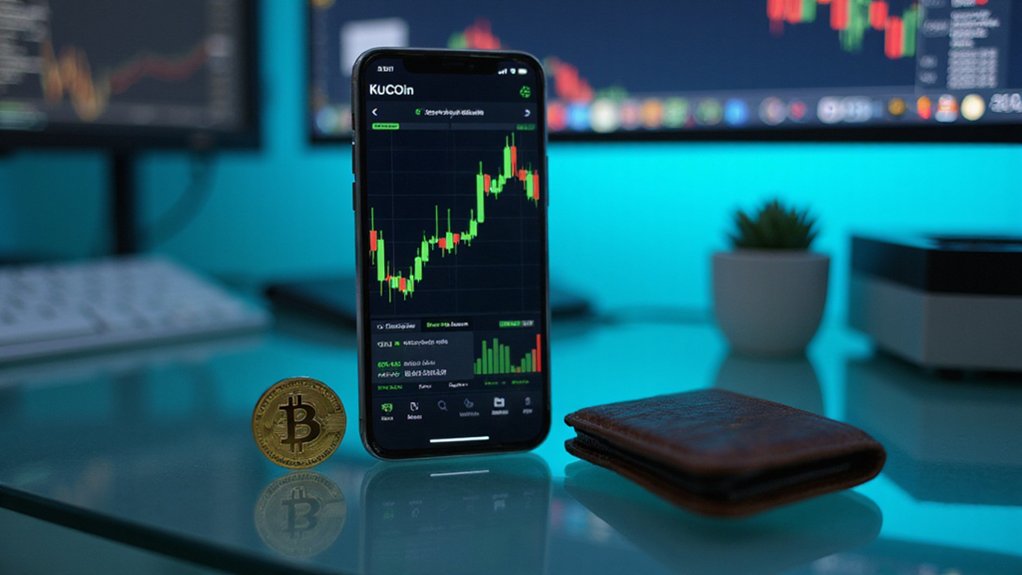KuCoin’s app offers a surprisingly nimble onboarding experience, requiring mere minutes for verification before unlocking its triple-tiered interface options—Classic for beginners, Professional for the technically inclined, and Full Screen for the perpetually chart-obsessed. Users can execute spot trades, leverage positions up to a white-knuckle 125x, or deploy automated bots while maintaining security through cold storage and two-factor authentication. The passive income features—staking and fixed deposits—reveal KuCoin’s deeper ecosystem beyond mere trading mechanics.

The rapidly evolving landscape of cryptocurrency trading demands platforms that can keep pace with both market volatility and user expectations—a challenge the KuCoin App appears determined to meet.
Available on both iOS and Android devices, KuCoin offers a robustly secured onboarding process requiring email or phone verification supplemented by mandatory two-factor authentication (a baseline security feature that, remarkably, some platforms still consider optional).
KuCoin’s interface architecture accommodates both neophytes and seasoned traders through three customizable layouts—Classic, Professional, and Full Screen—each integrating TradingView charts for technical analysis that would satisfy even the most zealous pattern-hunting chartist.
The app’s trading functionalities span the contemporary spectrum: spot trading across hundreds of pairs, margin positions with leverage up to 10x, and futures contracts that—for those with appetites for financial aventurism—offer leverage reaching a dizzying 125x (though one might question the wisdom of such exposure in markets already notorious for volatility). The new Cross Margin Mode feature enables users to distribute funds across multiple positions, significantly reducing liquidation risks.
Beyond conventional trading, KuCoin has cultivated an ecosystem of passive income opportunities through staking programs and fixed deposits. The platform’s Airdrop Calendar enables users to discover and participate in high-value airdrop events that can significantly expand their crypto portfolio without additional investment. Users can maximize benefits by completing tasks specified by protocols to qualify for token distributions.
KuCoin Token holders enjoy reduced trading fees—a loyalty incentive structure that has become de rigueur among exchanges competing for user retention.
The January 2025 update introduced enhanced trading tools, though specific details remain somewhat nebulous.
KuCoin Pay represents perhaps the most compelling integration for daily utility, enabling seamless fiat-to-crypto onramps via multiple payment channels including bank transfers and credit cards.
It includes Apple Pay integration for KuCard holders.
The platform’s security infrastructure—employing cold storage for majority fund holdings, withdrawal address whitelisting, and continuous monitoring for suspicious activities—represents industry-standard protective measures against the ever-present threat of digital asset theft.
For traders seeking algorithmic assistance, KuCoin’s automated trading bots offer programmatic execution across several cryptocurrencies—an acknowledgment that in today’s markets, even retail traders increasingly rely on automation to execute strategies with precision that manual trading cannot match.
Frequently Asked Questions
How Does Kucoin’s Security Compare to Other Cryptocurrency Exchanges?
KuCoin’s security infrastructure broadly aligns with industry standards, offering the requisite multi-layered wallet systems, 2FA, and anti-phishing mechanisms that characterize reputable exchanges.
Where it diverges, however, is in its regulatory standing—somewhat less established than competitors like Binance or Coinbase.
Its insurance-backed custodial arrangements provide welcome protection, though the exchange’s regulatory challenges (particularly in the U.S.) might give cautious investors pause.
The cold storage emphasis represents sound practice in an industry where hot wallet vulnerabilities remain pervasive.
Can I Use Kucoin Without Completing KYC Verification?
Users can indeed access KuCoin without completing KYC verification, though with substantial limitations.
While withdrawal services remain available (a curious allowance, considering regulatory trends), non-verified accounts cannot make deposits or open new margin positions and futures contracts.
Basically, these users exist in a curious financial limbo—able to sell cryptocurrencies and close existing positions but barred from the platform’s full functionality that would enable meaningful participation in the cryptocurrency ecosystem.
What Fees Does Kucoin Charge for Different Trading Activities?
KuCoin’s fee structure varies by trading activity, with spot trading commanding a base 0.1% for makers and takers (reducible via KCS payments or volume tiers), futures trading offering more competitive rates at 0.020% maker/0.060% taker, and options at 0.03% with a 10% premium cap.
The exchange mercifully waives deposit fees while withdrawal costs—fixed per transaction—fluctuate by blockchain.
One might consider these rates fairly competitive in today’s exchange ecosystem, particularly for high-volume traders.
Does Kucoin Support Automatic Recurring Purchases?
KuCoin indeed supports automatic recurring purchases through its aptly named “Recurring Buy Feature.”
This functionality enables users to implement dollar-cost averaging—that time-honored strategy beloved by the patient investor—by scheduling fixed-amount cryptocurrency purchases at predetermined intervals.
The system allows selection of any supported cryptocurrency, customizable investment amounts, and various frequency options (weekly, monthly, etc.).
Perhaps most valuable is how it systematically removes emotional decision-making from the equation, a blessing for those prone to market-timing misadventures.
How Long Do Withdrawals Typically Take to Process?
Withdrawals on KuCoin typically process within 30 minutes of submission, though blockchain confirmation times vary considerably with network congestion.
Large transactions trigger manual processing protocols (inevitably extending timelines).
The cryptocurrency type itself dictates baseline processing parameters, while fiat withdrawals operate on different timescales altogether—sometimes instantaneously, sometimes requiring the archaic patience of waiting two business days.
Additional verification hurdles like 2FA, while necessary security measures, further extend the withdrawal choreography.









